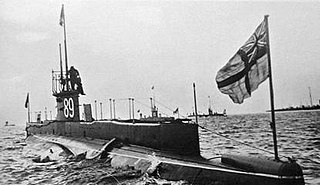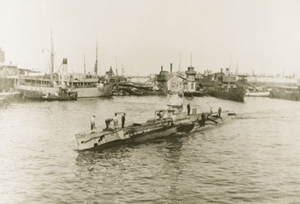
HMS E2 was a British E class submarine built by Chatham Dockyard. E2 was laid down on 14 February 1911 and launched on 23 November 1912.

HMS E1 was a British E-class submarine that was built by Chatham Dockyard and cost £101,700. E1 was laid down on 14 February 1911. She was launched on 9 November 1912 and was commissioned on 6 May 1913. During World War I she was part of the British submarine flotilla in the Baltic.

HMS E7 was a British E class submarine built at Chatham Dockyard. She was laid down on 30 March 1912 and was commissioned on 16 March 1914. She cost £105,700.

HMS E8 was a British E-class submarine built at Chatham Dockyard. She was laid down on 30 March 1912 and was commissioned on 18 June 1914. She cost £105,700. During World War I she was part of the British submarine flotilla in the Baltic.

HMS E9 was a British E class submarine built by Vickers, Barrow. She was laid down on 1 June 1912 and was commissioned on 18 June 1914.
HMS E10 was a British E class submarine built by Vickers, Barrow-in-Furness. She was laid down on 10 July 1912 and was commissioned on 10 March 1914. She cost £105,700. E10 was lost in the North Sea on or around 18 January 1915.
HMS E54 was a British E class submarine built by William Beardmore, Dalmuir. She was laid down on 1 February 1915 and was commissioned in May 1916. She sank UC-10 on 21 August 1916 and U-81 on 1 May 1917. E54 was sold for scrap on 14 December 1921.
HMS E16 was an E-class submarine built by Vickers, Barrow-in-Furness for the Royal Navy. She was laid down on 15 May 1913 and was commissioned on 27 February 1915. Her hull cost £105,700. E16 was the first E-class to sink a U-boat, U-6, sunk 4 mi (6.4 km) south-west of Karmøy island off Stavanger, Norway on 15 September 1915. E16 was sunk by a mine in Heligoland Bight on 22 August 1916. There were no survivors.

HMS E17 was a British E-class submarine built by Vickers, Barrow-in-Furness. She was laid down on 29 July 1914, launched on 16 January 1915 and was commissioned on 7 April 1915. HMS E17 was wrecked off Texel in the North Sea on 6 January 1916. Her crew were rescued by a Dutch cruiser Noordbrabant. They were interned. The conning tower of E17 is preserved as a monument at the Royal Navy Submarine Museum in Gosport, the United Kingdom.

HMS E20 was a British E-class submarine built by Vickers, Barrow-in-Furness. She was laid down on 25 November 1914 and was commissioned on 30 August 1915. She was sunk, torpedoed by UB-14, on 6 November 1915.
HMS E21 was a British E class submarine built by Vickers, Barrow-in-Furness. She was launched on 24 July 1915 and commissioned on 1 October 1915. E21 was sold on 14 December 1921.
HMS E22 was a British E-class submarine built by Vickers, Barrow-in-Furness. She was laid down on 27 August 1914 and was commissioned on 8 November 1915.
HMS E49 was an E-class submarine built by Swan Hunter, Wallsend for the Royal Navy. She was laid down on 15 February 1915 and was commissioned on 14 December 1916. E49 was mined off the Shetland Islands on 12 March 1917. The minefield was laid by the German U-boat UC-76 on 10 March 1917. There were no survivors. E49 lies 96 ft (29 m) down with her bows blown off.
HMS E48 was a British E class submarine launched by Fairfield Shipbuilding and Engineering Company, Govan in 1916 and was completed by William Beardmore and Company, Dalmuir. She was launched on 2 August 1916 and was commissioned in February 1917.
HMS E25 was a British E class submarine built by William Beardmore and Company, Dalmuir. She was, along with the future E26, one of a pair of submarines ordered by the Ottoman Navy on 29 April 1914, but was taken over by the Royal Navy and assigned the E25 name. She was laid down in November 1914, launched on 23 August 1915, and was commissioned on 4 October 1915. HMS E25 was sold on 14 December 1921.
HMS E26 was a British E class submarine built by William Beardmore and Company, Dalmuir. She was, along with the future E25, one of a pair of submarines ordered by the Ottoman Navy on 29 April 1914, but was taken over by the Royal Navy and assigned the E26 name. She was laid down in November 1914, launched on 11 November 1915, and was commissioned on 3 October 1915.
HMS E27 was a British E class submarine built by Yarrow Shipbuilders, Scotstoun. She was launched on 9 June 1917 and commissioned in August 1917. HMS E27 was sold to John Cashmore Ltd in Newport for scrapping on 6 September 1922.
HMS E33 was a British E class submarine built by John Thornycroft, Woolston, Hampshire. She was launched on 18 April 1916 and was commissioned in November 1916. E33 was sold to John Cashmore Ltd for scrapping at their yard in Newport on 6 September 1922.
HMS E36 was an E-class submarine built by John Brown, Clydebank for the Royal Navy. She was laid down on 7 January 1915 and was commissioned on 16 November 1916.
HMS E37 was a British E class submarine built by Fairfield, Govan, Clyde. She was launched on 2 September 1915 and commissioned on 17 March 1916. E37 was lost in the North Sea on 1 December 1916. There were no survivors.







